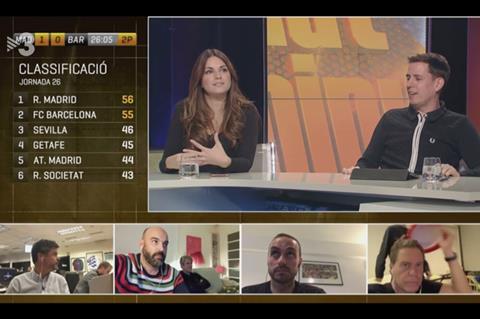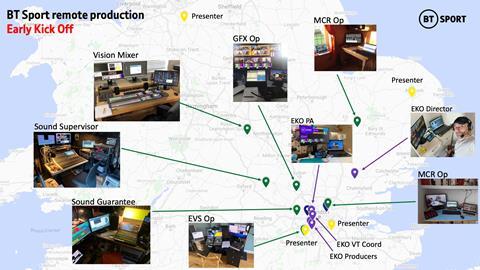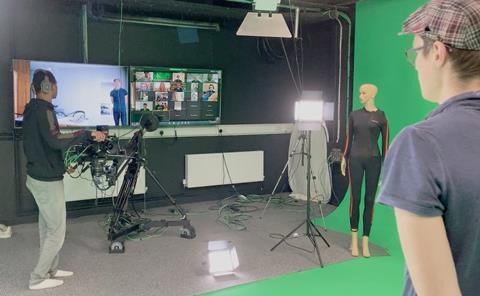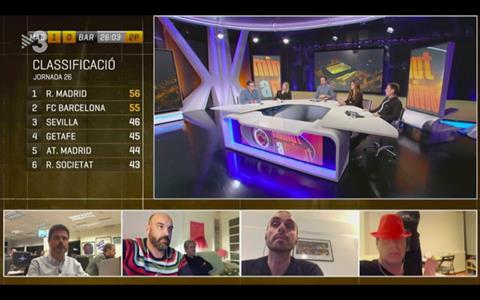Live programming has arguably never been more essential for linking the national community. Broadcasters are adapting to production regimes of remote host and audience interaction, with lessons and innovations that will stand the test of time.

With social distancing measures in place, broadcasters are having to innovate in order to keep their schedule busy and retain as much normality as possible.
All audience hosted live and as-live shows across most of Europe have been pulled or reformatted, with many finding ingenious ways to maintain continuity.
Virtual broadcast gallery
Although it has the option of using its studios in Stratford, BT Sport has taken the editorial decision to reconfigure its output for a series of live remotely produced programmes.
Jamie Hindhaugh, COO for BT Sport, said: “We could have got talent into the studio. I could have gone into the studio. But I felt that anything we did as a broadcaster had to reflect the challenge our audience are facing. We don’t want to be promoting the idea that travel is in anyway helpful at this time.”
Working with facility Timeline TV and graphics team Moov and led by chief engineer Andy Beale, BT Sport has created a virtual studio gallery operating at a scale which is arguably larger than any broadcaster has achieved before.
All the roles of the conventional studio gallery including PA, producer, vision mixer, director, EVS operator and graphics operators are now decentralised in different houses across the UK.
‘Anything we did as a broadcaster had to reflect the challenges our audience are facing’ Jamie Hindhaugh, BT Sport
“The PA is in her dining room, the director in their garage,” says Hindhaugh. “Normally they would be working next to each other. The technical undertaking is huge.”
Links are via broadband and 4G. Some on-screen talent have had broadcast cameras set up in their home, others have remote controlled PTZ cams. Some are even using the latest iPhone enabled for broadcast use by Timeline TV.
The first show to go this route was Sunset+Vine production Early Kick Off, recorded from the home of presenter Jake Humphrey and broadcast at 11am on Saturday 28 March (future shows will be live).
Guests, including Robbie Savage and Rio Ferdinand, contributed from home.
Humphrey tweeted: “I’ve done some interesting TV in my time. However, producing a 90-minute football show this Saturday, with 5 guests, none of us leaving our homes and my only crew member standing outside a window… will take some beating.”
Last Sunday, 29 March, was also the first of a MotoGP series produced by North One, which mixed live from home presentations with archive re-runs of classics voted for live by the audience. Engagement has been high, according to Hindhaugh. “Live relevant programming is vital at this time to allow audiences to contribute to hot topics.”
Two rugby union shows including Rugby Tonight Live, a Champions League highlights show with live punditry on last season’s games and comedy show The Football’s Not On with Ian Stone are all being produced with this virtual set up.

While BT Sport maintains a skeleton staff of just ten at its Stratford hub, the entire remote operation including IT support, is managed outside the building. Programme feeds are ingested back through Stratford for playout.
“Our vision mixer has a monitor for all feeds at their home,” says Hindhaugh. “We’ve literally managed to take apart a gallery and relocate it in different locations. The biggest issue is around delay, which is dependent on how fast individual connections are.”
- Webinar Working remotely in a crisis (Weds 15 April)
He says he will be determined to change how BT Sport works moving forward. “This workflow means you can have a more inclusive workforce, employing people who could normally not get to Stratford.
“We are creating a new format that goes alongside our continued development of 8K, Dolby Atmos for mobile and Object Based Broadcasting,” he adds. “We’ll now be able to go back with these learnings and drive more audience engagement.”
Live entertainment takes to the sofa
ITV aired Ant & Dec’s Saturday Night Takeaway live without a studio audience on 21 March and pre-recorded the last in the series after cancelling the planned finale from Disney World. The duo instead showed highlights from the series via links from their sofas at home.
In the US, late night chat and comedy shows including those fronted by Ellen Degeneres, Stephen Colbert, Jimmy Fallon, Seth Meyers, Trevor Noah and John Oliver are no longer filming with an audience.
So Television is planning to record The Graham Norton Show from the host’s home with guests linked on webcam when the new series begins on April 10. Other specially commissioned quarantine formatted shows on the BBC include Fulwell 73’s Peter Crouch: Save Our Summer; The Choir: Britain In Lockdown (Twenty Twenty) in which choirmaster Gareth Malone will connect amateurs and professionals remotely. The Mash Report from Zeppotron will feature the whole cast filming themselves at home; and Hat Trick’s production of the 59th series of Have I Got News For You will have guests and regulars connected remotely.
“Whilst a number of global productions have been paused, there is still an important need to entertain the nations, and this is at the core of what we do,” says Jane Atkinson, SVP global production, Fremantle. “For live programmes still on air and where it is safe to do so, it’s important that we deliver the audience the remainder of that season to its conclusion. These shows are being completed without audiences in a pared back style, with strict social distancing and health and safety rules in place, and they are achieving their goals of keeping audiences entertained.”
Fremantle is using various technology to continue broadcasting, often from people’s homes. Utilising widely available video conference systems such as Zoom through to more professional set ups with VMix and Skype TX, it is able to connect with hosts and on-screen talent.
For example, Italy’s weekly chat show EPCC Alive is now broadcast on Sky’s YouTube channel via Zoom. Norway Idols is being filmed without an audience, as was the finale of Italia’s Got Talent.
Chris O’Dell, head of global entertainment production, Fremantle, says: “In some countries we’re still able to broadcast with small OB set ups using [Dutch vendor] Mobile Viewpoint. In these scenarios hot head cameras, mics and simple lights are set up, whilst the occupants of the house are isolated in other rooms, and left to be run remotely.”
Fremantle is also using Marantz equipment, sending kits into people’s homes and remotely talking them through set up with a video call. Marantz kit includes the Turret, an HD desktop webcam with H.264 video compression, condenser microphone with pop filter and a daylight-balanced LED light ring for podcasts and streaming. Additional webcams are proving a useful way of providing a ‘gallery view’ on show participants.
‘Our biggest challenge in all of this is the robustness of local internet connections and the increased domestic demand’ Chris O’Dell, Freemantle
“In all set ups, our protocol is that everyone must first and foremost follow their own government guidelines, any crew to be kept to a minimum, and remove all physical contact with participants,” O’Dell says.
“We are using the same connecting technology to run production teams, and plan for future shows. Remote casting of contributors is underway, along with daily team planning meetings. Edits are home-based, using a wide range of cloud-based solutions and supported remotely by external post production houses.”
Other programmes Fremantle has retooled include Got Talent España which transferred to social and became Got Talent En Casa, available on YouTube, Facebook and Instagram. In the Netherlands, RLT 4’s daily chat show RTL Boulevard continues to broadcast from host Olcay Gulsen’s home via an OB with Skype TX and contributors on Zoom.
O’Dell adds: “Our biggest challenge in all of this is the robustness of local internet connections and the increased domestic demand. For safety and stability, pre-recording content helps.”
World first live remote virtual production
On 31 March, in what production partner Mo-Sys claim is claiming as a first example of its kind, a live corporate video for a major US-based CRM solutions specialist featured contributors connected to talent in the studio via Zoom, and in turn integrated into a virtual production. Mo-Sys technology included remote real-time access to the Unreal graphics engine and the StarTracker camera tracking system. Even the director was remote from the studio, calling the show in real time over Zoom.

Audience management and social integration
TVU Networks has seen adoption rates for its TVU Anywhere and TVU Talkshow software soar. “They’ve gone from ‘good to have’ to ‘must have’,” says CEO Paul Shen.
The apps use the firm’s legacy in live transmission links to deliver ‘broadcast quality’ live streams from a smartphone.
“Hundreds of journalists and producers are simultaneously casting using our TVU Anywhere app,” claims Shen. “News reporters for China’s CCTV are using it to stream live from the intensive care wings of hospitals in Wuhan.”
TVU Talkshow is an audience engagement tool for live screening and call management.
“Broadcasters can accept a thousand callers simultaneously – since they’re all cloud instances,” Shen says. “The app manages audio too so that viewers can hear the guest clearly, but not the reverb of the conversation from their connection.”
Spanish public broadcaster Televisió de Catalunya’s (TV3) Esport3 aired its sports chat show Minut a Minut using the apps to simultaneously host more than 25 football fans during a two-hour live studio hosted broadcast. The connection was made possible by providing fans with a QR code via the app to pair their mobile device to a remote TVU Server.

Integrating social media into a live show is arguably more important than ever with live reactions to social likely to increase audience engagement.
The last three weekly editions of ITV’s The Martin Lewis Money Show have broadcast without a live studio audience. Producer Multi Story Media used Never.no’s online audience management tool Bee-On to gather viewers’ tweets tagged with #MartinLewis to create the conversation on Twitter. Working with pre-made native broadcast graphics, Bee-On pushed the content, in real time, to a large screen in the studio, where Lewis and his co-host were able to highlight and discuss the topics.
Multi Story Media continues to use the technology in a similar way on ITV’s political flagship The Peston Show.
Studios retain continuity
“The global situation is changing fast and a live show has the advantage of current information,” says Andy Waters, head of studios, dock10. “But viewers want more than news. They want to be entertained and live entertainment will help lift the spirit of the nation. Keeping the UK’s kids informed and entertained is more important than ever during this time.”
As part of the national broadcast infrastructure, all dock10’s TV and radio studios plus post production, will remain open and operational through the Coronavirus outbreak. It is continuing to host shows for CBBC and CBeebies including Saturday MashUp!, Newsround and Blue Peter.
It operates a skeleton shift in the facility and has ensured that the vast majority of both clients and staff can work from home or in isolation.
“We’ve built a bespoke remote edit solution around dock10’s network infrastructure which has been key to allowing our editors and edit producers to keep working from home,” says Ian Dodd, head of post production. “This infrastructure also allows for remote automated ingest of rushes meaning that edits can be completely self-contained and isolated. QC is another area that has been facilitated to work remotely.
“All of our dubbing and VFX creatives are able to work remotely from home via this remote network, and our online editors and colourists are currently isolating within separate parts of the dock10 building,” Dodd adds.
BBC Studioworks is facilitating live news-based, political and magazine-style programming from TV Centre and its post production service is still operating from BBC Elstree Centre.
‘We are now managing an increased tech responsibility – a new ‘normal’ for guest appearances is via Skype/video links’ Andrew Moultrie, BBC Studioworks
Measures include stripping back studios in terms of reducing large props and stunts, so productions can run with reduced crew members, as well as setting up video links so crew who would usually have been based in the studio can watch and comment from rehearsals at home.
Andrew Moultrie, CEO, BBC Studioworks says: “The lack of audiences also means that our rostra can be used for the floor crew to spread out safely, and our large gallery spaces have social distancing protocols in place. We are now managing an increased tech responsibility – a new ‘normal’ for guest appearances is via Skype/video links. Working with our partners we’re focusing our attention on those elements of sets which are truckable and can be easily moved whilst still adhering to the latest safety guidance.”
Technical and workflow challenges
Time is of the essence. With front-of-camera talent increasingly in their own homes, taking part in a live production managed somewhere else, “producers and production partners do not have time to investigate solutions – we have to go with something we know will work out-of-the-box,” says Malcolm Robinson, business development at systems integrator Broadcast Solutions.
You can get a kit to do this for £500 – many YouTubers do it this way – but to at least get near the customary high production values there are other means.
“A better-quality camera would make a significant difference, but system cameras will have the challenge of encoding the signal for online delivery,” says Robinson.

Multiple contribution feeds need processing so that they match. Cameras need racking remotely, so universal camera control systems are required. A studio automation system is needed to bring all the elements together into a reasonably simple command workflow.
“This could be the moment when VR really takes off, so multiple individuals can be integrated into a set, rather than appearing as a set of squared-off boxes on screen,” says Robinson. “A sports chat show, for example, could have three or four pundits appearing to sit around the same desk, even if they are all remote contributions.”
If you are going to do VR then you need a portable green screen – these are readily available. PTZ cameras with tracking data will help site individual images into the whole more naturally. At the hub, you will need a VR system that can accommodate multiple moving cameras, which means it will probably be based on the Unreal engine.
“Under the social distancing guidelines, the goal must be to have no crew on site,” Robinson says. “That means choosing equipment that is proven and capable of practical, low-latency remote operation.
“We work with broadcasters who are used to spending a year on a project, drawing up a requirement specification, testing it against the market, running proof of concept tests and finally implementing and rehearsing the new solution. We cannot do this now. We need to be able to put together solutions based on what we can get, connect and install by the end of the week; the end of next week at the absolute latest. That’s the challenge and we manage the risk of that challenge.”
There are no typical workflows. “We have to create what we need from what we can get,” says Robinson. “But critical to success will be proven automation technology to minimise the number of technicians needed at the hub.”
‘We need to be able to put together solutions based on what we can get, connect and install by the end of the week; the end of next week at the absolute latest’ Malcom Robinson, Broadcast Solutions
All remote feeds will be brought to a central hub, which might itself be a virtual production centre. In this hub you will have all the attributes of a live broadcast: a director creating the pace and flow; vision switching and audio mixing; graphics; quality control and the rest. Simple, networked tools will make this possible – as long as you understand the collaboration required.
“News will require large-scale remote access to resources, to scripting and editing, and to creating and managing the run-downs,” Robinson explains. “That is a significant security issue, incidentally: you do not want a trusted news source to be hijacked.”
Artificial intelligence has an important part to play, from managing agency feeds to clipping stories as they are first broadcast for catch-up and social media.
“Machine learning is going to be increasingly important if this situation continues,” Robinson says.
While reasonably fast broadband is now widely available, it is subject to fluctuations and is generally asymmetric. That is a particular issue here because it is the upload speed that is of greatest need.
“The connection needs to have good bandwidth bi-directionally,” Robinson says. “Programme output needs protected bandwidth as an uplink, with the downlink providing camera and audio control, script and data feeds. Ideally it will also provide for return video so that individual artists can see and react to other content and performances.”
Unless you have fibre to the location, that probably means you are going to need a bonded connectivity solution, using cellular connectivity to bolster the broadband and provide the necessary stability and resilience.
Creative quarantine commissions
Channel 4 says it has been overwhelmed by the “resourceful and creative ideas” received from indie producers and has ordered a number of them under the banner of Lockdown Academy.
Among them is daytime daily The Steph Show (Expectation / Can Can Productions), currently being broadcast live from Steph McGovern’s living room in Yorkshire.
Coronavirus: Life in a Day is being shot today (Friday 3 April) across the UK, combining user-generated footage with footage shot by indie True Vision Yorkshire. It aims to capture life in lockdown over 24 hours and will be edited for a rapid turnaround TX on April 6.
Octogenarian Margie Keefe presents Grime Gran from self-isolation in her East London flat, to be shown everyday next week on E4.
After the success of Jamie Oliver’s hastily vamped new cook-a-long series, Kirstie Allsop’s Kirstie’s House of Craft will feature the presenter offering creative ideas for the whole family from her own house.
At ITV, Shine TV has been commissioned to make a one-off show for ITV about the ways people are coping in isolation following the spread of Covid-19. Contributors are being supplied with specially designed mobile phone rigs, allowing them to self-shoot, record and remotely download footage to edit teams.
Tim Whitwell, creative director at Shine TV, said of the documentary: “I’ve never worked on a show where directors never meet contributors - so this is a cutting- edge approach to a fast-changing and unprecedented period in our national life
























No comments yet